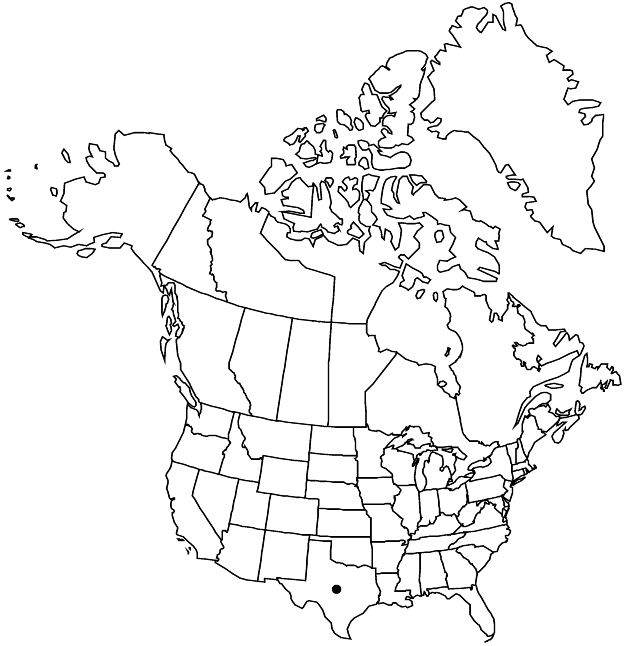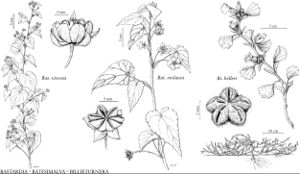Difference between revisions of "Bastardia viscosa"
in A. von Humboldt et al., Nov. Gen. Sp. 5(fol.): 199.
5(qto.): 256. 1822.
Illustrated
Basionym: Sida viscosa Linnaeus Syst. Nat. ed. 10, 2: 1145. 1759
Synonyms: Bastardia guayaquilensis Turczaninow B. parvifolia Kunth S. bastardia de Candolle S. foetida Cavanilles
Treatment appears in FNA Volume 6. Treatment on page 237.
FNA>Volume Importer |
imported>Volume Importer |
||
| (6 intermediate revisions by 2 users not shown) | |||
| Line 1: | Line 1: | ||
{{Treatment/ID | {{Treatment/ID | ||
|accepted_name=Bastardia viscosa | |accepted_name=Bastardia viscosa | ||
| − | |accepted_authority=(Linnaeus) Kunth | + | |accepted_authority=(Linnaeus) Kunth |
|publications={{Treatment/Publication | |publications={{Treatment/Publication | ||
|title=in A. von Humboldt et al., Nov. Gen. Sp. | |title=in A. von Humboldt et al., Nov. Gen. Sp. | ||
|place=5(fol.): 199 | |place=5(fol.): 199 | ||
| − | }}{{Treatment/Publication | + | }}, {{Treatment/Publication |
|place=5(qto.): 256. 1822 | |place=5(qto.): 256. 1822 | ||
|year=1822 | |year=1822 | ||
| Line 11: | Line 11: | ||
|special_status={{Treatment/ID/Special_status | |special_status={{Treatment/ID/Special_status | ||
|code=F | |code=F | ||
| − | |label= | + | |label=Illustrated |
}} | }} | ||
| − | |basionyms={{Treatment/ID/ | + | |basionyms={{Treatment/ID/Basionym |
|name=Sida viscosa | |name=Sida viscosa | ||
|authority=Linnaeus | |authority=Linnaeus | ||
| + | |rank=species | ||
| + | |publication_title=Syst. Nat. ed. | ||
| + | |publication_place=10, 2: 1145. 1759 | ||
}} | }} | ||
|synonyms={{Treatment/ID/Synonym | |synonyms={{Treatment/ID/Synonym | ||
|name=Bastardia guayaquilensis | |name=Bastardia guayaquilensis | ||
|authority=Turczaninow | |authority=Turczaninow | ||
| − | }}{{Treatment/ID/Synonym | + | |rank=species |
| + | }} {{Treatment/ID/Synonym | ||
|name=B. parvifolia | |name=B. parvifolia | ||
|authority=Kunth | |authority=Kunth | ||
| − | }}{{Treatment/ID/Synonym | + | |rank=species |
| + | }} {{Treatment/ID/Synonym | ||
|name=S. bastardia | |name=S. bastardia | ||
|authority=de Candolle | |authority=de Candolle | ||
| − | }}{{Treatment/ID/Synonym | + | |rank=species |
| + | }} {{Treatment/ID/Synonym | ||
|name=S. foetida | |name=S. foetida | ||
|authority=Cavanilles | |authority=Cavanilles | ||
| + | |rank=species | ||
}} | }} | ||
|hierarchy=Malvaceae;Malvaceae subfam. Malvoideae;Bastardia;Bastardia viscosa | |hierarchy=Malvaceae;Malvaceae subfam. Malvoideae;Bastardia;Bastardia viscosa | ||
| Line 44: | Line 51: | ||
|elevation=0–500 m | |elevation=0–500 m | ||
|distribution=Tex.;e Mexico;West Indies;Central America;South America (Colombia;Ecuador;Peru;Venezuela). | |distribution=Tex.;e Mexico;West Indies;Central America;South America (Colombia;Ecuador;Peru;Venezuela). | ||
| − | |discussion=<p>Bastardia viscosa is known only from the lower Rio Grande valley.</p> | + | |discussion=<p><i>Bastardia viscosa</i> is known only from the lower Rio Grande valley.</p> |
|tables= | |tables= | ||
|references= | |references= | ||
| Line 53: | Line 60: | ||
-->{{#Taxon: | -->{{#Taxon: | ||
name=Bastardia viscosa | name=Bastardia viscosa | ||
| − | + | |authority=(Linnaeus) Kunth | |
| − | |authority=(Linnaeus) Kunth | ||
|rank=species | |rank=species | ||
|parent rank=genus | |parent rank=genus | ||
| Line 67: | Line 73: | ||
|publication title=in A. von Humboldt et al., Nov. Gen. Sp.; | |publication title=in A. von Humboldt et al., Nov. Gen. Sp.; | ||
|publication year=;1822 | |publication year=;1822 | ||
| − | |special status= | + | |special status=Illustrated |
| − | |source xml=https:// | + | |source xml=https://bitbucket.org/aafc-mbb/fna-data-curation/src/2e0870ddd59836b60bcf96646a41e87ea5a5943a/coarse_grained_fna_xml/V6/V6_425.xml |
|subfamily=Malvaceae subfam. Malvoideae | |subfamily=Malvaceae subfam. Malvoideae | ||
|genus=Bastardia | |genus=Bastardia | ||
Latest revision as of 22:21, 5 November 2020
Plants 0.5–1.5 m. Stems often malodorous, sometimes also with simple hairs 2 mm. Leaf blades 4–8 cm (often smaller), apex acute to acuminate. Inflorescences usually leafy panicles. Pedicels slender. Flowers: calyx 4–5 mm, viscid; corolla usually 6+ mm, petals 4–5 mm. Schizocarps 5–6 mm diam.; mericarps muticous. Seeds 2 mm. 2n = 28.
Phenology: Flowering year-round.
Habitat: Shrublands, thickets, disturbed vegetation, pastures, roadsides
Elevation: 0–500 m
Distribution

Tex., e Mexico, West Indies, Central America, South America (Colombia, Ecuador, Peru, Venezuela).
Discussion
Bastardia viscosa is known only from the lower Rio Grande valley.
Selected References
None.
Lower Taxa
None.
